#women workers
Text
Part of the reason that we don't tend to think of medieval women as workers is that the major expectation for them was that they would be wives and, crucially, mothers. A young woman, no matter her place in society, spent much of her time preparing for her eventual role as wife and mother in the household of her husband's family. Her parents wanted to ensure that they brought up their daughter in such a way that she would not "be a sore vexation to her bridegroom," as the Church father and theologian John of Chrysostom (347-407) put it. So when a young unmarried woman did receive, say, an education, it was largely tied to investing in her theoretical value as a bride. Well-educated women made for good wives since they could later educate their own children, as we will see. They would also be expected to run their own households, a job that involved fiscal acumen, and in the case of larger households, to manage staff. When a medieval girl was educated, it wasn't necessarily an altruistic activity to better her for her own good. It was a calculated marketing strategy and a means of marking her as an excellent potential mother.
The focus on motherhood and the getting of heirs existed for a number of reasons. As discussed in Chapter 3, for the rich, it was a way of ensuring that the property that a family had amassed would be passed down to a younger generation and their interests would be protected. Poor families needed children not necessarily to safeguard property but to have help on it. In an agricultural society, extra hands to help on the farm were in demand, especially when they didn't have to be paid wages. But regardless of whether you wanted kids to carry on your legacy or to help on the farm, you had to contend with one significant barrier: infant mortality. Children died at an incredibly high rate, not only in the medieval period but up until the twentieth century. At the very lowest, somewhere between 20 and 30 percent of all medieval children under seven died, though some put the mark as high as 50 percent. As a result, families required many more births of children than we are accustomed to in order to ensure viable heirs.
Producing all the heirs that their male relatives demanded put women's lives in real danger, but this danger was an accepted part of their position and calling as wives. The Hali Meidhad or Letter on Virginity, which was written in the English Midlands, acknowledged the pain, danger, and worry of mothers, stating that "in carrying [a child] there is heaviness and constant discomfort; in giving birth to it, the cruelest of all pains, and sometimes death; in bringing it up many weary hours. . . . By God, woman, . . . you should avoid this act above all things, for the integrity of your flesh, for the sake of your body, and for your physical health." The danger and pain—the real labor of childbirth and child rearing—were thus not lost of medieval commentators. This was the job that medieval women were expected to carry out, and it sucked.
Beyond childbirth and -rearing, the position of wife in and or itself implied work. According to Jerome, "Men marry, indeed, so as to get a manager for the house, to solace weariness, to banish solitude." The Letter on Virginity likewise directly challenges the idea that women benefit from subsuming themselves into marriage and motherhood. When a submissive would-be wife states that men's strength is needed for help with work and to secure adequate food, and that wealth is the result of marriage and several healthy children, the Letter asserts that such a picture of marriage deliberately misleads women, and that any advantages that they experience from marriage and motherhood come at too high a personal cost. Marriage, the Letter insists, is not a way of forming a team and enjoying a family but is "servitude to a man." Sugarcoat it one might, but marriage was not a romantic partnership but a contract, in which women signed themselves up for a life of grinding maternal labor as well as work alongside their husbands, for which they would not be acknowledged in historical records.
Medieval women appear as parts of households, or “wives of” named men in historical records. But wives were expected to take on the role of helpmeet and coworker alongside their husbands. Even those who heeded the warnings of the Church and turned from a life of motherhood toward God would find themselves working away inside nunneries. Similarly, single laywomen had to work to get by, and society marked out positions specifically for women who, for whatever reason, were not attached to a household. All these women are worth seeing as workers.
-Eleanor Janega, The Once and Future Sex: Going Medieval on Women’s Roles in Society
#eleanor janega#women workers#women’s work#female oppression#womens history#motherhood#medieval history
189 notes
·
View notes
Text
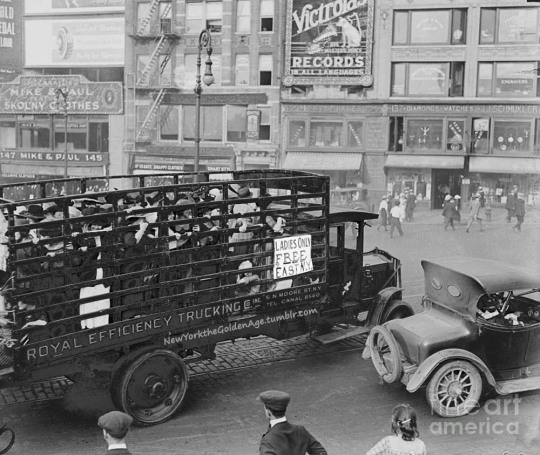
A jitney truck carrying female workers from the city to East New York, NJ, during a labor strike in 1921.
Photo: Bettmann Archive/Getty Images/Fine Art America
36 notes
·
View notes
Text
‘Rosie the Riveters’ honored with Congressional Gold Medal for WWII efforts
25 notes
·
View notes
Text

Making brass fittings for military tanks, Darian D. Smith, 1943
20 notes
·
View notes
Photo







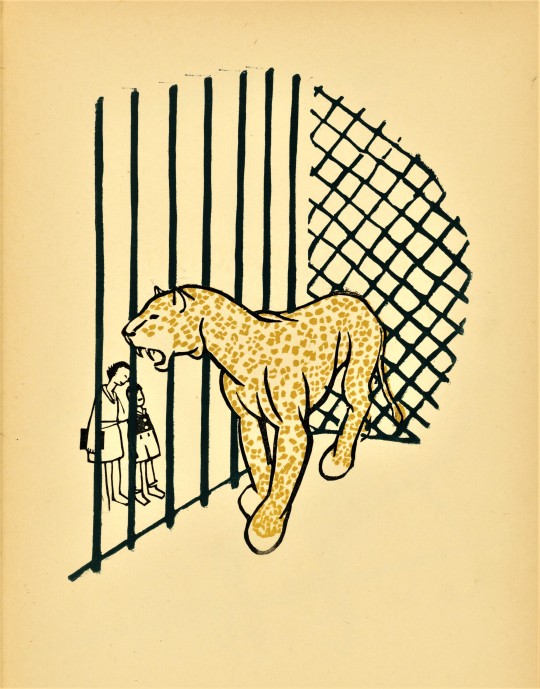


Milwaukee Handicraft Monday
The Milwaukee Handicraft Project (MHP) of the Wisconsin WPA produced several block-printed and handbound books for children in the late 1930s. Among them was this title, At the Zoo, A Book of Block-Prints, with blocks cut by Milwaukee-area artist Kendrick Bell (1913-2004) and the book printed and bound by specially-trained, but formerly unemployed and unskilled Milwaukee-area women laborers. The MHP was highly successful at hiring and training around 5,000 people in total throughout its seven year existence during the Great Depression.
At the Zoo is about animals at the Washington Park Zoo, situated on land designed by famed American landscape architect Frederick Law Olmsted. The zoo opened in 1892, but by the time this book was produced, the park had become a little worse for wear. Planning for a newly-designed zoo began in 1942, and fundraising began in earnest in 1956. The new zoo opened in 1958 as the Milwaukee County Zoo, which is still in operation today. Perhaps its most famous resident was Samson (1949–1981), a male silverback western lowland gorilla. Today the zoo is known for several exhibits, but it is perhaps most well-known for the visitor-favorite Humboldt Penguin Pool at the zoo’s main entrance, and for its population of bonobos, the largest outside their native home in the Congo.
Shown here are a few of the animals Kendrick Bell would have encountered at the zoo in the late 1930s, although we think Old Mr. Leopard gets a bad rap!
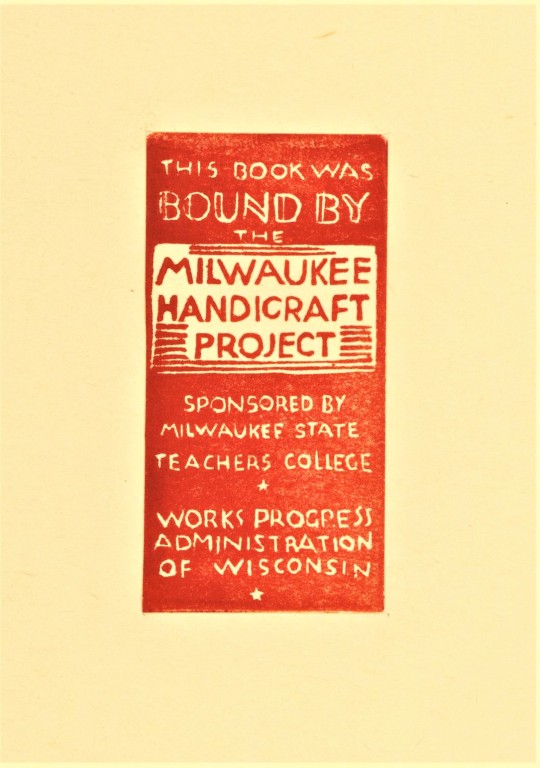
View more posts about MHP and the Wisconsin Arts Projects of the WPA.
#Milwaukee Handicraft Monday#Milwaukee Handicraft Project#Works Progress Administration#WPA#block prints#Kendrick Bell#At the Zoo#animals#poetry#Washington Park Zoo#Milwaukee County Zoo#children's books#women workers#Historical Curriculum Collection
99 notes
·
View notes
Text
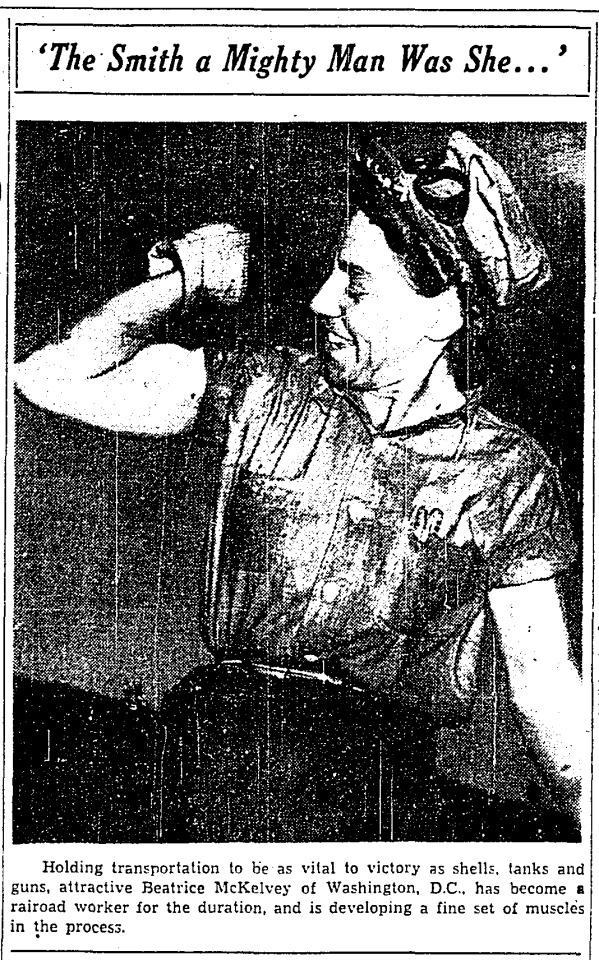
""The Smith a Mighty Man Was She…" Toronto Star. October 10, 1942. Page 3.
---
Holding transportation to be as vital to victory as shells, tanks and guns, attractive Beatrice McKelvey of Washington, D.C., has become a railroad worker for the duration, and is developing a fine set of muscles in the process.
#washington dc#railway workers#women workers#war workers#women at war#women's empowerment#united states history#world war ii#muscular women#women in history
16 notes
·
View notes
Text
Hey Ladies!!
Don’t know how this will go over, but I thought I’d give it a try 🤷♀️
I work for a small, woman-owned business! All workers are women, with a significant portion of us being lesbians!
Every product is anti-microbial, meaning it will inhibit germs, molds, fungus, and more. The brand was created after my boss got seriously ill from picking up a germ at a public gym.
Supporting us and our mission to keep everyone healthy would really mean a lot ❤️

Me and The XB Zip Pocket lol ^^
#the pure bag#woman owned business#woman owned small business#small buisness#women workers#terfs do touch#terfs please interact#terf safe#radblr
20 notes
·
View notes
Text
Not Naruto.
I am one of those few people in the world probably, who actually likes their boss.
Okay yes, like some other ornery bosses, she will send you work mail at 12 am. She will constantly forward you stuff on social media platforms that she thinks will be helpful for the work. She will give you work after hours. Of course, if it's not a deadline, she doesn't expect you to respond right away.
She gives very mixed instructions sometimes and you have to tactfully drag it out of her as to what she wants. She sometimes calls you to her cabin and simply looks at you confusedly for a second before collecting her thoughts. Sometimes she excitedly starts talking Before you have entered her cabin. Sometimes she talks to you speaking loudly from her cabin. Smh. She will not have saved your number on her phone even though you have worked multiple projects together. Lol. No seriously, she wanted to give me her recipe for a savoury dish she had recently sent a certain bad tempered minister that we both regularly make fun of, she handed me her phone and asked me to forward it to mine. My number was not saved. I told her so. She genuinely laughed, shyly. She had the grace to be embarrassed about it. I honestly don't know how she still managed to maintain coherent communication with me given how many people she talks with in a day. But regardless, she expects your work to be just as she wants it. She doesn't compromise with it. I am always in two minds about greeting her when crossing her cabin as I am getting ready to leave... She can be weird sometimes.
But despite all of that, I like her. Because no matter how much ever the employees know they work, and they do, they know for a fact that she works more. This old, frail lady in her seventies works more in one day that a few others perhaps do in a week.
It might sound like toxic work culture and who knows, maybe it is, lol. But it's social sector and it really does get the short end of the budget stick.
But looking at my boss, looking at how much she has accomplished or awards she has won, I know she will give it all back right away if it meant she could benefit those who generally seep through the cracks, in complete anonymity and are forgotten a second after they do. She is one of those who honestly aren't looking for credit. Well, not official credit anyway.
I like her because she is honest. And she does the lion's share of the work. It's like she never stops. The reason that makes me want to work for her is to make it easier for her. Lol. She is nice.
15 notes
·
View notes
Note
there's a guy at work who's said some really creepy shit to women, myswlf included. my boyfriend told me to ignore it because the guy gets bullied a lot and he feels bad. how should i approach my bf about that? i thought he was the guy i wanted to marry but i don't want someone who lets other men talk to me that way.
Hi love. I'm so sorry that you had to learn that your boyfriend harbors these misogynistic values, especially if you otherwise thought he was someone you were compatible enough with to see yourself marrying someday. Validating how devastating that must be!
I'm incredibly glad, though, you clearly see that his thinking, not yours, is the problem here and that you're not making any justifications for his inexcusable mentality.
I would ask him why he thinks you should ask him why he believes this is the way you should handle this, and how he would personally deal with a gay man at work who made creepy comments towards him and his other straight male colleagues. Would he then care if he was bullied? Try to see as clear as day what his remark says about his life values and philosophy. Does he think that it's women's role/obligation to ensure men feel comfortable, or is he not emotionally intelligent enough to understand that being bullied is no excuse for treating others poorly?
This sounds like a case of someone who needs to go to therapy to learn to deconstruct his insidious patriarchy hardwiring. I hope that he can work on himself and change his beliefs/words and actions once he recognizes/educates himself on his blindness or blissful ignorance to the constant harassment women are expected to endure/how we are silenced when all we're declaring is our right to equity.
Best of luck! Hope this helps xx
#workplace discrimination#workplace wellbeing#workplace culture#relationship advice#relationship dynamics#relationship tips#feminism#intersectional feminism#womens rights#gender roles#equal rights#women workers#femmefatalevibe#q/a#patriarchy#women's empowerment#femme fatale#dark femininity#dark feminine energy#it girl#high value woman#the feminine urge#queen energy#female power#dream girl#female excellence
6 notes
·
View notes
Text
#international women's day#women empowerment#women workers#news#articles#digitalnews#indiannews#tech news
0 notes
Text

0 notes
Text
i'm always a bit unsettled by disdain for intellectual or creative labor in leftist spaces. there's this commonly held belief that academics are a bunch of rich old white men, rather than a wide variety of people who are barely getting by. most lecturers in universities are adjuncts living paycheck to paycheck. authors make very little money as a general rule. most researchers are overworked and underpaid. and yet there's still this idea that academics are overcompensated to sit around and smoke cigars together while making shit up
#seeing the response to the plagiarism video of 'this is a victimless crime' rubs me the wrong way#these are your fellow workers who are having their work stolen by people making considerably more money#and by and large the people whose work gets stolen are the people who the plagiarists think they can more easily steal from#namely people of color and especially women of color and lgbt people of color#especially the poorest among them without substantial backing or large audiences
9K notes
·
View notes
Text
Levittown, Pennsylvania ‘Rosie the Riveter’ to accept Congressional Medal of Honor
https://whyy.org/articles/rosie-the-riveter-congressional-medal-of-honor/
0 notes
Text

Walter Langley
'Breadwinners'
1896
Seen at the Worcester Museum and Art Gallery
0 notes
Text
Got a new position? Congratulations!
0 notes
Text
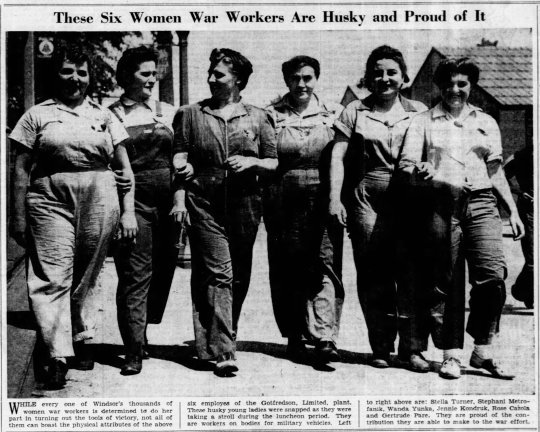
"These Six Women War Workers Are Husky and Proud of It," Windsor Star. June 23, 1943. Page 5.
-----
WHILE every one of Windsor's thousands of women war workers is determined to do her part in turning out the tools of victory, not all of them can boast the physical attributes of the above six employes of the Gotfredson, Limited, plant. These husky young ladies were snapped as they were taking a stroll during the luncheon period. They are workers on bodies for military vehicles. Left to right above are: Stella Turner, Stephani Metrofanik, Wanda Yunka, Jennie Kondruk, Rose Cabola and Gertrude Pare. They are proud of the contribution they are able to make to the war effort.
#windsor#disciplinary society#women in history#women at war#social construction of bodies#fashion photoshoot#canada during world war 2#tank factory#war workers#industrial workers#metal workers#war propaganda#working class history#home front#women workers#husky girls#fat shaming sort of
3 notes
·
View notes